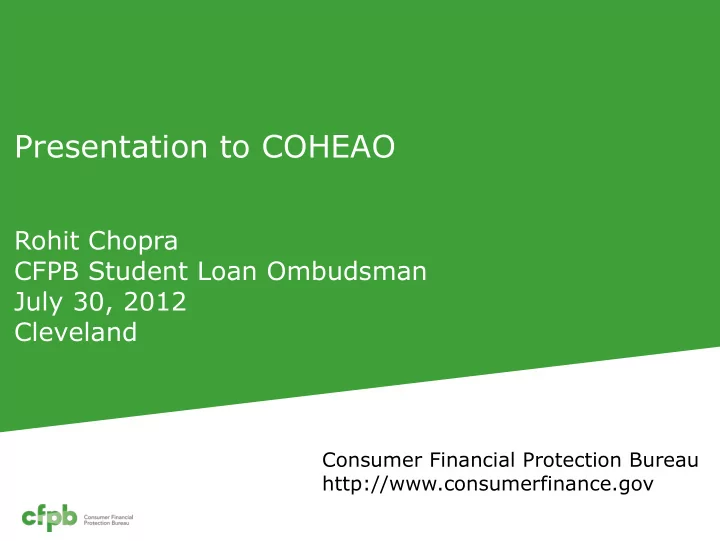

Presentation to COHEAO Rohit Chopra CFPB Student Loan Ombudsman July 30, 2012 Cleveland Consumer Financial Protection Bureau http://www.consumerfinance.gov
Establishment of the CFPB In July 2010, the Dodd-Frank Wall Street Reform and Consumer Protection Act was enacted, which created an independent consumer agency to oversee the financial services marketplace. The Act provides for the CFPB to engage in financial education, research, rulemaking, supervision, and enforcement. In July 2011, consumer protection functions from other bank regulators transferred, and the CFPB began supervising the nation’s largest financial institutions In January 2012, with a Director in place, the CFPB assumed its full toolkit, including its authorities over nonbank entities In March 2012, the CFPB launched the student loan complaint system at consumerfinance.gov Earlier this month, the CFPB and ED released a Report to Congress on Private Student Loans
CFPB and the Student Loan Market Supervision: Provides for supervision of nonbank private student lenders, regardless of size, on a risk basis; supervision of all depository institutions with assets in excess of $10 billion Enforcement: Provides for enforcement authority over a set of enumerated Federal consumer financial laws, many of which apply to origination, servicing, and debt collection activities Consumer complaints: Establishes an ombudsman for private student loans within the CFPB with annual reporting requirements to Congress Rulemaking: Authority to issue regulations under certain Federal consumer financial laws transfers to the Bureau (i.e. Truth-in-Lending Act, Fair Debt Collection Practices Act) Consumer Education: Heavy emphasis on financial education, with specific reference to college financial aid in Dodd-Frank
Report to Congress on Private Student Loans With the Department of Education, the CFPB submitted a report to Congress on private student loans, pursuant to Dodd-Frank Market rapidly grew prior to 2008, but rapidly contracted after dislocations in the capital markets Market has $150B in outstanding debt, with over $8B in default Borrowers might have been confused by differences between federal and private CFPB recommendations to Congress included: - requiring school certification of all private student loans - revisiting bankruptcy standard - modifying definition of a private student loan - providing students with a total picture of all student debt (like NSLDS)
Defining “Larger Participants” Dodd-Frank gave the Bureau authority to supervise nonbank “larger participants” in the financial services marketplace CFPB must define “larger participant” through the rulemaking process In February 2012, CFPB proposed a rule that would define “larger participants” in the debt collection industry The public comment period for this rule closed in April and we expect to issue a final rule defining larger participants in the debt collection industry later this year.
Student loan complaint system open for business Dodd-Frank instructs CFPB to assist borrowers with private student loans Borrowers can submit complaints by phone, fax, U.S. mail or by using our online portal Through our call center, we can accept complaints and inquiries in over 180 languages
Consumer-facing web portal When things don’t go according to plan, CFPB can help student loan borrowers: • Getting a Loan • Repaying A Loan • Unable to Repay A Loan Borrowers will get a tracking number and will get a response from their lender, which the CFPB will review
Our company web portal offers real-time tracking and updates on complaints CFPB has enrolled the largest private student lenders and servicers on our company web portal CFPB will continue to enroll companies as we scale up This online interface allows companies to see complaints and respond to consumers in real-time
Our student loan complaint process Since the launch of the complaint intake process for student loans, we have heard from borrowers facing a number of challenges, including: • Difficulties making full payment; • Confusing advertising or marketing terms; • Billing disputes; • Deferment and forbearance issues; and • Debt collection and credit reporting problems. Consumers receive a tracking number after submitting a complaint and can check the status of their complaint through the CFPB website. CFPB expects companies to respond to complaints within 15 days and detail the steps they have taken or plan to take. CFPB expects companies to close complaints in 60 days. Each complaint will be processed individually and consumers will have the option to dispute the lender’s resolution, referring their complaint to an investigator
Our complaint system will also point borrowers to our interactive web tools CFPB works to educate borrowers who file a complaint. Our Student Debt Repayment Assistant helps borrowers understand their repayment options. Borrowers can learn more about: • Income-Based Repayment • Deferment for Military Service or Economic Hardship • Public Service Loan Forgiveness
Online Tools: Student Debt Repayment Assistant and Debt Collection Assistant These interactive tools help borrowers navigate various student loan options. Thousands of borrowers have used these tools at ConsumerFinace.gov Borrowers can learn more about: • Avoiding Default • Curing Default on Federal and Private Student Loans • Income-Based Repayment • Deferment and Forbearance
Financial Aid Shopping Sheet CFPB and the Department of Education partnered on an effort to improve financial aid offers. The model form includes: • Clear indication of loans and grants • Estimates for debt upon graduation, along with monthly payment • School quality indicators, including the loan default and graduation rate
Ask CFPB: A Question and Answer Platform
Visit Us Online to Participate www.ConsumerFinance.gov
Questions? Consumer Financial Protection Bureau http://www.consumerfinance.gov
Recommend
More recommend